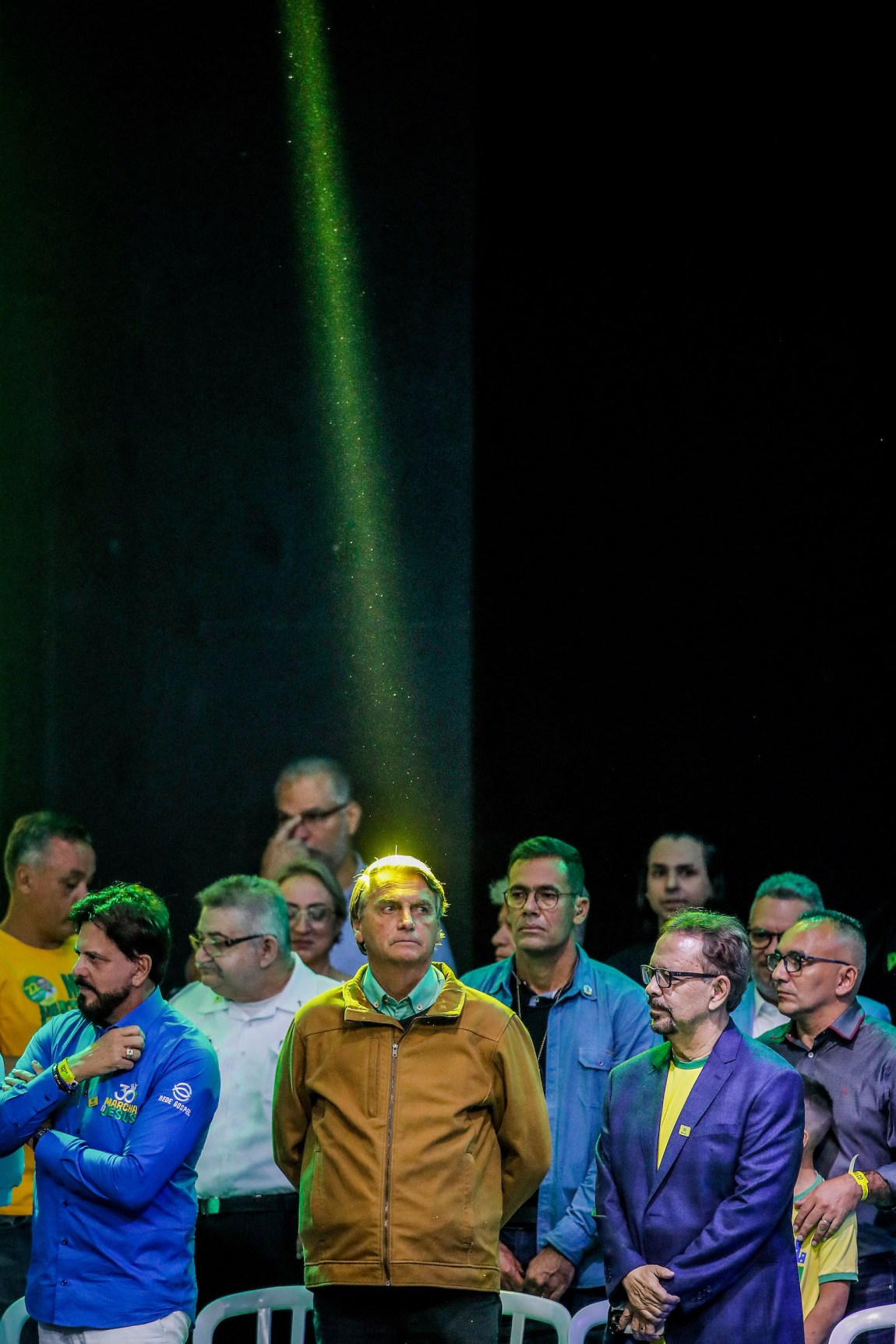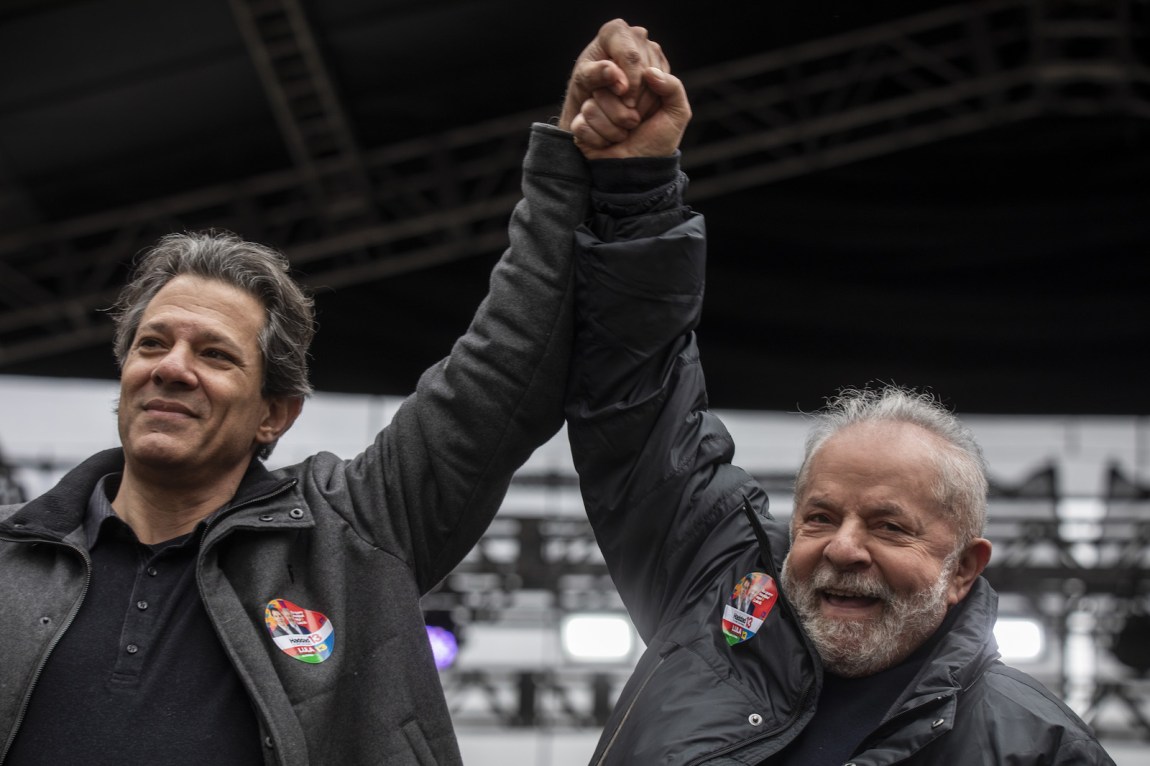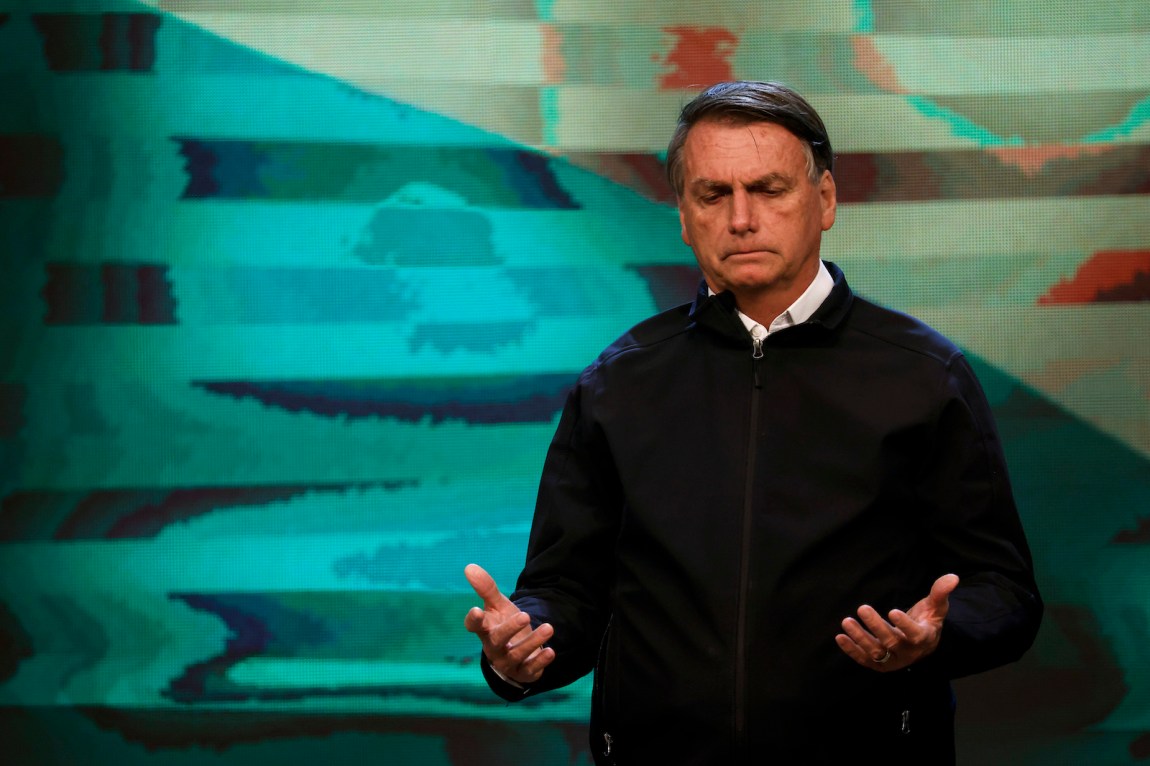At the beginning of 2013, there was seemingly no one on the right in Brazil’s political system. No one who admitted it, anyway. The Workers’ Party (Partido dos Trabalhadores, or PT) was confidently sailing through its third presidential term, and the former guerrilla Dilma Rousseff was enjoying approval ratings only slightly lower than the record set by her predecessor, Luiz Inácio “Lula” da Silva, who ended his mandate with the support of more than 80 percent of Brazilians. The main opposition party, the Brazilian Social Democratic Party (PSDB), was called right-wing by PT supporters, but denied this vigorously. Like the rest of the most visible actors in the country, they had defined themselves in opposition to Brazil’s brutal, US-backed dictatorship, which ended in the 1980s. Before the 2014 elections The Economist lamented that out of thirty-two registered parties, twenty-six had names with left-wing signifiers. The Brazilian political spectrum, the political scientist Luiz Felipe d’Avila told the magazine, was “fifty shades of pink.”
Five years later the right was out in the open. After mass protests, economic crisis, a reckless anticorruption campaign, President Rousseff’s removal, and Lula’s imprisonment, the country elected Jair Bolsonaro, now probably the most extreme-right leader in the democratic world. He won power in 2018 with the backing of economic elites, and a wave of explicitly conservative politicians—fire-breathing YouTubers, anti-environmentalists, and demagogues—filled the halls of the Congresso Nacional.
Now Lula is back. He solidly beat Bolsonaro in the first round of voting on October 2, with 48 percent of the vote to Bolsonaro’s 43. If he wins again on Sunday, then by law Bolsonaro has to go. Elite support for Bolsonaro is less solid than when he took office, and although he has made it exceedingly clear at every point in his career that he would be happy to carry out a coup and destroy Brazilian democracy, he may actually leave.
But even if he does, voting so far has shown that his movement has taken on a more concrete form since 2018, seizing strategic centers of power. “To speak of ‘Bolsonarismo’ is not the same as speaking of Bolsonaro voters,” the Brazilian philosopher Rodrigo Nunes writes in his recent essay collection, Do Transe à Vertigem (“From Trance to Vertigo”). “Smaller than Bolsonaro’s actual or potential electorate, Bolsonarismo is at the same time bigger than Bolsonaro himself: neither created by nor solely dependent on the individual from whom it borrows its name.”1
The first-round results proved Nunes’s point. Bolsonaro may have lost to Lula in that round, but Bolsonarismo had a surprisingly good day at the ballot box. Voters gave important governorships to extreme-right candidates, elected a powerful conservative bloc in Congress, and delivered an apparent death blow to the respectable center right, the “Social Democrats” that backed Rousseff’s impeachment in 2016. The PSDB has governed São Paulo, Brazil’s richest and most populous state, since 1994—but its candidate lost in the first round to the PT’s Fernando Haddad, who came in behind Tarcísio de Freitas, Bolsonaro’s former infrastructure minister.
Brazil’s pro-democracy forces, now accustomed to living in fear of authoritarian rupture, nervously watch the news and try to convince the country’s few remaining undecided voters to take their side. In this battle they now have an argument many wish they didn’t. Last week I saw a voter named Marina try to convince her father, a former Bolsonaro voter who picked a third-party candidate in the first round, to vote for Lula. “If Bolsonaro gets another term there will be nothing stopping him,” she said. “If Lula wins, he will have to negotiate constantly with conservatives, so you don’t have to worry.” She thinks her father, who owns a small business outside São Paulo, will be reassured that the country won’t turn into Venezuela or Nicaragua, one of the baseless and constant lines of attack by the right. “This is what Lula has always done—build coalitions and govern responsibly,” she said. That is more or less what the Brazilian left hopes they can pull off next year. At best, politics here in 2023 will be a mix of Workers’ Party red and Bolsonarista yellow.
*
How did the right return to the public sphere? A careful book by Camila Rocha, a political scientist at the Centro Brasileiro de Análise e Planejamento, is crucial to understanding the beginning of this story. In Menos Marx, mais Mises: O liberalismo e a nova direita no Brasil (“Less Marx, More Mises: Liberalism and the New Right in Brazil”), she points to the importance of two groups: a set of free-market think tanks and a constellation of right-wing online communities.2 The think tanks, with names like Instituto Liberal, Instituto Mises, and Instituto Millenium, arose between the 1980s and the first decade of the twenty-first century, usually with ideological or financial supporters in the United States. Almost all Brazilian elites, not just the rightists, look frequently to the north for inspiration, but “liberal” here means something different than it does in the US. These liberais are radical neoliberals, or libertarians, or anarcho-capitalists, and most have gleefully rejected the pieties of progressivism and identity politics.
Advertisement
The online communities—first on the social media platform Orkut, then on Facebook—often revolved around Olavo de Carvalho, a reactionary Brazilian philosopher who lived in Virginia until his death earlier this year. A communist in the 1960s, Carvalho moved to the right and drew on Gramsci to formulate the idea of leftist hegemony in Brazilian intellectual life—the claim that citizens here had unconsciously accepted Marxist premises. He proposed using a rhetorical “shock politics”—cursing, insulting, refusing to respect the authority of gatekeepers—to pierce the veil. Rocha offers an eloquent historical explanation of “Olavismo,” which is welcome, since Carvalho often demanded that his interviewers read all of his books before sitting down with him and liked to flood the Internet with wildly provocative and distracting allegations, such as his claim that Pepsi used aborted fetuses to sweeten its soda.
The dictatorship here had little time for the likes of Hayek and Mises. Neoliberalism, as Gabriel Boric recently put it, had Chile for its cradle—not Brazil. Before the US-backed military coup in 1964, North Americans supported the golpista Instituto de Pesquisas e Estudos Sociais (IPES), a Brazilian institution linked to those that had created neoliberalism as an intellectual project, like the Mont Pelerin Society. But once the generals took over, the radical liberal project fell by the wayside, in favor of the fanatical anticommunism and corrupt developmentalism favored by economic elites. Starting in the 1980s Brazilians set up institutions with the support of the Atlas Network, based in Arlington, which has been called a “neoliberal Comintern,” Rocha notes approvingly.3 But the think tanks were by and large happy with the direction the country took under the PSDB’s Fernando Henrique Cardoso between 1995 and 2002, when companies were privatized and private markets expanded for education and healthcare.
The grand return of the free-market think tank came in the second Bush administration and then just after the 2008 financial crisis, when the Koch Brothers began to fund Tea Party actions undermining the Obama administration. Between 2005 and 2010 a number of groups popped up in Brazil, both with local and international support. Rocha reports that one of the founders of Students for Liberty Brazil, a local chapter of the US nonprofit, took part in the Koch Summer Fellow Program in the United States, and that the new Instituto Ordem Livre was connected to the Cato Institute, but she points out that these institutions had many committed Brazilian sponsors, too. Notably, when an economist named Paulo Guedes—who got his Ph.D. from the University of Chicago, then taught in Pinochet’s Chile—needed someone to help found the new Millenium Institute, he tapped Rodrigo Constantino, who got his start as a prolific poster in the right-wing corners of Orkut.
Neither the Olavistas nor the liberais were behind the protests in June 2013—those began when a left-autonomist group demanded the government reverse a bus fare rise—or the economic and political crises that arrived in Brazil not long after. But they were both able to step into the political vacuum those explosions created. In 2014, after Rousseff barely pulled off reelection, the Olavistas, the new liberals, and the old-school hard right came together, implacably opposed to letting her serve a second term. From the beginning, they were joined on the street by Eduardo Bolsonaro—who had just taken a course at the Mises Institute, and whose father, Jair, had been praising the military dictatorship and calling for a cleansing wave of violence since the 1990s—and another group of online radicals that openly called for a military “intervention,” that is, a coup.
This alliance caused tensions in the liberal camp, which was supposed to be committed to free markets and political freedom. But the protest movement was fundamental in pushing for Rousseff’s removal. Organizations born from the world of right-wing think tanks were some of the first on the streets. They soon commanded large, influential digital operations and put direct pressure on Congress to move forward with an impeachment that many consider to have been a parliamentary coup—all while presenting as grassroots movements committed to expanding political and economic freedoms.
The weakening of the Workers’ Party was accomplished with the help of the investigation Lava Jato (“Operation Car Wash”), led by the judge Sergio Moro. With the assistance of an eager media in Brazil and abroad, and working with the US Justice department, Moro shone a light on real corruption, on the system of carving funds out of big public contracts that had undergirded Brazilian politics since re-democratization. He also bent rules and broke laws to make sure that Lula was in jail before Jair Bolsonaro won the 2018 election. Bolsonaro immediately appointed Moro his Justice Minister. Paulo Guedes became Finance Minister and took charge of the Brazilian economy.
Advertisement
The political crisis that began after 2013, and Rousseff’s removal three years later, created an environment in which elite opinion mattered far more than it should in normal democratic circumstances. After the impeachment, Michel Temer mounted a pro-market government with practically no support from the population, and many judicial experts believe that Moro’s freewheeling and ultimately right-wing crusade would have been checked by higher courts if not for its support in the media. Traumatized by the unexpected right-wing turn of the 2013 protests, pro-democracy Brazilians were left watching as Congress and the Supreme Court decided what would be acceptable in their political system.
*
The rise of the novas direitas—the mostly young, or at least young-presenting, new right—helps explain the rehabilitation of reactionary language in mainstream Brazilian discourse. In 2016, for instance, the respected newspaper Folha de S. Paulo gave a column to the new-right social media star Kim Kataguiri. Bolsonaro’s alliance with Guedes, meanwhile, helps explain why business leaders came to support his candidacy. An editorial in the stuffy, right-leaning Estado de S. Paulo calling the decision between Bolsonaro and his PT opponent, Fernando Haddad, “a very difficult choice” exemplifies ruling-class attitudes in 2018. They affected that they were holding their noses and then got behind the liberal–conservador package likely to suit their material interests.
But Bolsonaro himself was never a liberal of any type. He was a former army captain who spent his career in Congress defending the dictatorship and the interests of security services and the surrounding underworlds, and he rushed into a political crater created by the eruption of antipolitical sentiment in the country from 2013 to 2018. Because he was never important enough to be involved in the corruption scandals investigated by Lava Jato, he was able to present himself as a man opposed to the entire political system. He won the support of a lot of working-class Brazilians in 2018, including many who had voted for Lula. With legions of fake-news phalanxes active across Brazilian social media, he did especially well with white men in the middle class, and with the country’s conservative Christian community.
The problem for many elites, the political scientist Leonardo Avritzer has demonstrated, is that Bolsonaro governed “not like a political leader, but like someone disposed to destroy policy and politicians,” nominating ministers “in accordance with their ability to oppose their own departments.”4 The antisystemic candidate was now an antisystemic president and was ripping everything apart.5 Under Temer the government had “flexibilized” workers’ rights, and in his first year in office Guedes “reformed” social security by raising the retirement age and cutting spending. But even before 2020 it was clear that Guedes would have a hard time delivering the shining free-market future the liberal generation had envisaged, limited both by Congress and by a president uninterested in policy but very interested in his own political survival.
Then the pandemic arrived. When Bolsonaro took an aggressively irresponsible stance on the virus, he began to lose popularity in rich cities like Rio and São Paulo. At the same time, support grew for his relatively competent health minister, Luiz Henrique Mandetta, whom Bolsonaro forced out of office in April 2020. Over the next year Brazil had three more health ministers, and the country got the worst of both worlds: hundreds of thousands died, and the economy collapsed. Bolsonaro had not become more extremist or more antidemocratic than he always had been; he had simply revealed himself to be bad at governing. Instead of running a country twice the size of the European Union, he picked fights on social media, met constantly with his radical base, and rode around on motorcycles and Jet Skis.
This was not what the business community had hoped for. An anti-antipolitics coalition began to form, comprised of politicians, judges, and economic elites who believed that the instability of Bolsonarista would do more harm to the country than any good Bolsonaro could himself deliver. Meanwhile, Avritzer writes, the Brazilian media finally began to act responsibly. The outlets that had cheered on Moro’s often illegal offensive now, as a class, started adopting more of an anti-Bolsonarista stance. Anyone living or working in the centers of Brazil’s biggest cities could see that the streets were now filled with wandering, starving families.
Bolsonaro lost not only many elites but also a lot of the new-right free-market crusaders. The president, facing a number of impeachment attempts, made a defensive pact with the so-called Centrão, the large group of ideologically uncommitted parties that offer support to anyone in return for political favors and resources. Congress created a huge “secret budget” that gives politicians direct control over billions in spending. With Lava Jato now killed and the Bolsonaro family surrounded by scandals, the idea that Brazil was becoming less corrupt, or that its capitalism was becoming more competitive, was laughable. As in many other cases of actually-existing neoliberalism, Guedes was delivering top-down class war without the transparency or free markets the campaign had promised.
*
Bolsonaro has made his opposition to the democratic order clear and taken every opportunity to cast doubt, without any evidence, on the voting system that elected him. In September 2021 he expended significant resources to get his base out on the street in an attempt to show that he had the muscle to seize power outside of institutional checks and balances. But in the wake of the disastrous pandemic, and after influential business and media classes have failed to make a “third way” center-right candidacy happen (they tried a lot of people, including Moro, to no avail), crucial sectors, including the military, have signaled that they could probably tolerate the return of the Workers’ Party—or at least that it isn’t worth backing a Bolsonaro coup to keep Lula out of power.
In August, top bankers signed an open letter in support of democracy. “We are passing through a moment of immense danger for democracy,” they declared. “There is no space for authoritarian backsliding. Dictatorship and torture belong to the past.” Representatives for Faria Lima, Brazil’s version of Wall Street, have spent this year trying to pressure Lula to move to the right and make promises to the business community. By the vote on October 2, it looked unlikely that Bolsonaro could lose and stay in power. Considering that every poll since 2021 had indicated that Lula would trounce the president, analysts focused on backroom dealings and elite consensus.
Immediately after the first round of voting much of the political establishment rallied behind Lula: the cantankerous center-left candidate Ciro Gomes backed him for the second round, as did the center-right Simone Tebet, and Fernando Henrique Cardoso himself, and then—most surprisingly—João Amoêdo, founder of the radical free-market, new-right NOVO party, who says he fears for democracy and will vote PT for the first time in his life. Over four years in power, Bolsonarismo lost many liberais and the respectable elites, and they may even lose the presidency.
But over the same four years, Bolsonarismo found elective affinity with a real base in Brazilian society. The extreme-right movement is especially popular with evangelical Christians, and it has a virtual lock on the country’s agricultural heartland—two forces growing in influence. In his book, Nunes describes Bolsonarismo as an alliance of classes with contradictory interests united by common enemies and overlapping discourses. It is not so hard to explain why small-scale farmers who may rely on deforestation and the invasion of indigenous territories to maximize their profits would line up behind a president that encourages both. Businessmen at the top of Brazil’s agriculture pyramid have distanced themselves from Bolsonaro, but under him things have been relatively good for the Amazon destroyers, cattle ranchers, and soy exporters.
Nor should international analysts be too surprised that Bolsonarismo has found support among the frustrated petty bourgeoisie, the classic base for fascism. Olavo de Carvalho did well to position himself in the online world of what Nunes calls “the would-be bureaucrat who failed the application (and blames affirmative action), the man who never become an alfa macho (and comes to blame feminism), the adult who feels intellectually inferior (and comes to blame cultural Marxism), and the struggling businessman.”
More of a mystery is the support for extreme-right candidates from poor, working Brazilians, who may have voted for Lula and battle for survival every day. One answer, cited by Nunes, comes from the anthropologists Rosana Pinheiro-Machado and Lucia Scalco, who point out that when the PT was in power it opted for policies of social “inclusion via consumption”—in other words, poor Brazilians were granted full citizenship through expanded spending power. When the economy slowed and that power shrank again, some of that support fell away. The latest polls show that Lula still leads among recipients of basic welfare payments (Bolsonaro rebranded Lula’s Bolsa Família family welfare program as Auxílio Brasil so that it would be associated with him), but by much less than he used to. These would often be the voters who, in Nunes’s account, are not themselves Bolsonaristas but may have voted to create a Bolsonarista bloc. Bolsonaro temporarily expanded assistance to poor Brazilians right before the election, and everything indicates that the government is now using the full powers of executive office, as well as that enormous “secret” budget, to flood the country with dark money that can be used to buy allies and persuade voters.
But Nunes also points to widespread subjective conditions in Brazil, including the spread of “neoliberalism from below” and the “entrepreneurship of the self,” in which every individual sees herself as a microbusiness poised to make it big—or worse, personally to blame for her own poverty. Bolsonarismo perhaps has no more exemplary figure than the life coach, or the grifter selling dubious financial advice in the slums—the man promising you will get rich if you give money to his church or sign up for his YouTube class. This group also did very well on October 2. Paulo Marçal, a millionaire life coach selling a course called The Worst Year of Your Life, was elected to Congress for São Paulo, and the candidate who received the most votes for a Chamber of Deputies seat in the entire country is a twenty-six-year-old evangelical TikTok star from the favela, who built a following by railing against communism and sex before marriage.
In the first round of voting Bolsonaro performed best with white men, as expected (Black women backed Lula nearly four to one). But support migrated out of the cities and into the rural areas strategically positioned to benefit from China’s demand for raw materials. Nor did Bolsonaro’s pandemic response necessarily hurt him in an absolute sense. (The former health minister Eduardo Pazuello, a hated figure of pro-science progressives, was elected to Congress in a landslide.) Rather it shifted his support to a “hyper-radicalized” base. The phenomenon that Nunes calls Bolsonarismo can easily outlast the Bolsonaro family itself, but it did not exist, Nunes argues, before his candidacy gave these diverse constituencies—emasculated men, religious conservatives, security forces and their backers, and the various “entrepreneurship” classes—a new movement to join, albeit one that is “neither coherent nor necessarily stable.”
In the final weeks of the campaign, Lula and Haddad zip around the country, visiting rich and poor voters alike, in the traditional Brazilian campaign style that gave the Workers’ Party power in the first place. “Lula helped people like us, and it’s as simple as that,” fifty-year-old Pedro Alves told me over the weekend at a small rally for both candidates in the poor city of Tiradentes, São Paulo. He pointed to his foot, disabled after an accident, and said, “If they return to power, I would get the help I need.” But in the final stretch of the election, much of the action is happening on terrain to which the PT does not have access: corners of social media dominated by the extreme right, and evangelical churches, some of which are reportedly pressuring the faithful to vote for Bolsonaro, or even pushing away those that won’t.
No one could have predicted the extent to which Brazilian political discourse has become dominated by the paranoid fever dreams of the masculine and Christian id. All the most provocative tropes are in play at the moment, on both social and traditional media: masonic conspiracy, pacts with the devil, pedophilia, feminist assault on gender, cannibalism, zoophilia. Most of this is classic material from the radical anticommunist tradition that trained Bolsonaro. But now this kind of attack is coming from both directions: a small number of pro-Lula figures online are slinging this mud from left to right, with the tentative support of the PT. Still, nearly 90 percent of Brazil’s robust influencer community, according to Pinheiro-Machado, is Bolsonarista. Much of that community came up in a world where the values of the extreme right felt natural. On vast swathes of social media progressives are now in the same position that the right was a decade ago, shouting and attacking and demanding to be heard.
The free-market liberals will be happy to do business with Bolsonaro if he wins, but they are not driving the movement. If you tried to summarize the changes in political culture since 2018, you might say: Menos Mises, mais Olavo. Less Mises, more Olavo de Carvalho. In the final week of the campaign, federal police arrived at the home of a longtime friend of the Bolsonaro family—and former congressman—to arrest him for violating the terms of his house arrest. He opened fire and threw a live grenade at them, injuring two. As one would expect, he immediately turned to the Internet and claimed that he was defending his rights—to post on social media.






